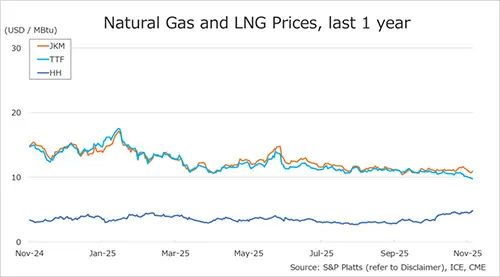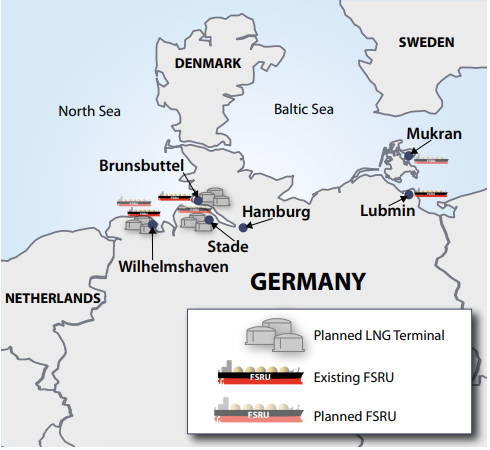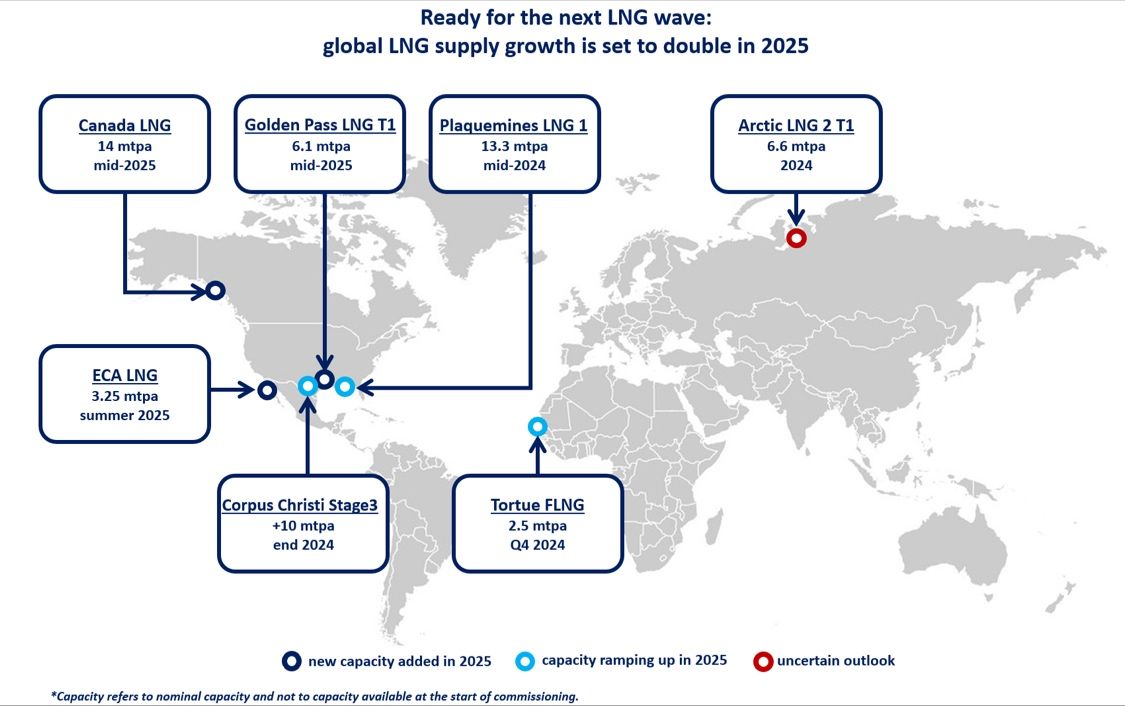

German onshore LNG import terminal developers are maintaining a positive outlook and hoping to reach final investment decisions (FID), with some planning to do so before year-end.
The three onshore projects aiming for FID are Hanseatic Energy Hub’s (HEH) Stade terminal, German LNG’s (GLNG) Brunsbuttel terminal and Tree Energy Solutions’ (TES) Wilhelmshaven terminal.
There are also floating storage and regasification units (FSRUs) that are either active or planned at these sites (see Table).
The terminal at Stade is expected to be the first to take FID, potentially before the end of the year. The €1 billion terminal is expected to begin operations by 2027 after Spanish energy company Enagas bought 10% of the consortium that forms HEH (see LNGWM, Sep ’23). Banks have been asked to provide funding for the terminal.
The 13.3-Bcm/y terminal has sold 12 Bcm/y of long-term capacity for over 10 years. EnBW has booked 6 Bcm/y for 10-plus years, Securing Energy for Europe (SEFE) has booked 4 Bcm/y for 20 years and Czech utility Cez recently secured 2 Bcm/y on a long-term basis.
Cez’s Stade capacity will replace its contract with the Eemshaven FSRU unit in the Netherlands, which expires in 2027. Cez’s Stade capacity is for 15 years with an option to extend for another 10 years. Cez is reported to be looking for long term supply from the US.
Stade’s remaining 1.3 Bcm/y of capacity will be allocated on a short-term basis via auctions, as requested by the German government. A FSRU is to arrive at the terminal in December, which will be managed by Deutsche Energy Terminal (DET), not by HEH.
GLNG’s terminal in Brunsbuttel received €40 billion of support from Germany, approved by the European Commission in July. The 10-Bcm/y terminal plans to begin operations by the end of 2026, though it has yet to secure FID, a decision which is expected to slip into early 2024.
The beneficiaries of support include German energy company RWE and the Dutch energy network operator Gasunie.
GLNG, which is building and operating the terminal, is owned by the German government via German investment and development bank KfW with a 50% share, Gasunie with 40% and RWE with 10%. The terminal, which is still waiting for construction permits, will secure funding from KfW.
The UK’s Ineos, US major ConocoPhillips (COP) and RWE have booked capacity at the terminal, although Shell’s original interest in long-term capacity at the terminal appears to have lost momentum.
COP is expected to supply 2 MMt/y of LNG to the terminal for 15 years starting 2026 as part of a deal with QatarEnergy. The supply will come from QatarEnergy’s North Field East and North Field South expansion projects.
COP will receive supply from its equity offtake in Qatar’s North Field Expansion projects.
TES is developing the import terminal at the Wilhelmshaven site, which it calls Wilhelmshaven Green Energy Hub, with Germany’s E.ON and France’s Engie.
The companies, along with DET have chartered a FSRU to serve the project which is to arrive this winter. TES plans to take FID on the onshore terminal in 2024, although it needs to secure permits to be able to move ahead.
Germany’s Planned LNG Infrastructure

The terminal is expected to have 15 Bcm/y of LNG capacity, most of which has been allocated on a five-year basis, despite the developer’s aim to have 20-year allocations. Up to 25 parties were reported to have shown interest during an open season in June 2022.
Capacity was allocated to 5-10 companies in heads of agreements and TES is working to convert these to binding commitments as soon as possible. One company opted out and the 3.4 Bcm/y capacity was made available to the market in October on a first committed, first served basis.
There have been at least two counterparties showing strong interest in this capacity, above rates initially agreed with the original counterparty.
Pricing is flat regardless of the size of capacity secured by a shipper on a €/MWh basis, although duration will affect the tariff. The TES reference is for a 20-year contract and higher rates will be paid for shorter contracts.
The German government has mandated that 10%, or 1.5 Bcm/y is reserved for short term allocations. The project will be funded by equity from shareholders and loans provided in a project finance structure.
TES’ Wilhelmshaven site and HEH’s Stade site are good locations for LNG import terminals as they are active ports that do not require dredging. Stade is already an import terminal for chemicals and an FSRU has been successfully deployed to TES’ Wilhelmshaven site.
The TES terminal will be connected to Open Grid Europe, one of Germany’s largest gas networks. GLNG’s Brunsbuttel, however, has had start-up issues relating to grid connectivity with its FSRU.
When the import terminals start up, German law stipulates that the FSRUs operating at those locations must leave. However, it is unclear whether this will affect the Esperanza which is on charter to Uniper at Wilhelmshaven. This FSRU is unrelated to the TES planned onshore terminal at Wilhelmshaven and its associated FSRU, the Excelsior, which is set to arrive at the beginning of next year.
Green energy ambitions
All three terminal operators have green ambitions which are in line with the German government’s net zero plans. HEH and GLNG plan to eventually provide facilities for ammonia storage. As part of Germany’s 2022 LNG Acceleration Act onshore terminals are obliged to provide services for green fuels from 2043 but there is political pressure to do this before 2040.
However, many industry participants think these goals will be hard to achieve and expect all three terminals to remain focused on LNG in the long term.
HEH and GLNG’s terminals will have a similar design which allows for storage of ammonia using a similar method of cladding in tanks, whereas plans call for TES’ Wilhelmshaven terminal to receive e-methane produced from green hydrogen.
Its advantage is that the e-methane molecule (CH₄) is the same as the methane that comes from hydrocarbon extraction, so facilities and ships do not need re-tooling.
TES and Australia’s Fortescue Future Industries (FFI) signed an agreement in 2022 that would allow for 300,000 tons of green hydrogen to be converted to e-methane and shipped to the TES terminal.
FFI also agreed to make a €30 million investment in TES to become a shareholder and provide €100 million for the construction of the terminal. TES hopes to be able to offer more favorable conditions on pricing and tenure for importing e-methane versus LNG.
TES has another agreement with Uniper and the Government of Lower Saxony to develop a jetty at Wilhelmshaven for the import of green fuels.
The agreement is in partnership with Niedersachsen Ports (NPorts), the largest operator of public seaports in Germany.
Generally, market participants are calling for further cost clarity on the green phases of these projects.
Source: Poten & Partners



